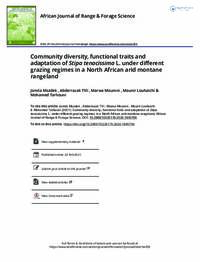Community diversity, functional traits and adaptation of Stipa tenacissima L. under different grazing regimes in a North African arid montane rangeland

Authors:
The mountain rangeland chain of Matmata (southern Tunisia) is characterised by an arid Mediterranean climate with severe droughts and high temperatures, combined with substantial human disturbance. In order to withstand these harsh conditions, plants have developed adaptive strategies and functional traits to survive. This study aims to evaluate the impact of three grazing regimes (grazing exclusion, seasonal and continuous grazing) on Stipa tenacissima L. functional traits, a dominant native and multi-use plant species, and its community. The findings suggest that the diversity of plant communities and traits of S. tenacissima are strongly affected by the management regime. Diversity is higher under seasonal grazing. Traits, such as leaf water content, specific leaf area and bio-volume are higher under seasonal grazing, compared with continuous grazing and/or sites fenced off to prevent grazing. Hence, seasonal grazing is recommended to maintain diversity of the plant community and to enhance the adaptation strategies of the local species under montane dryland conditions.
